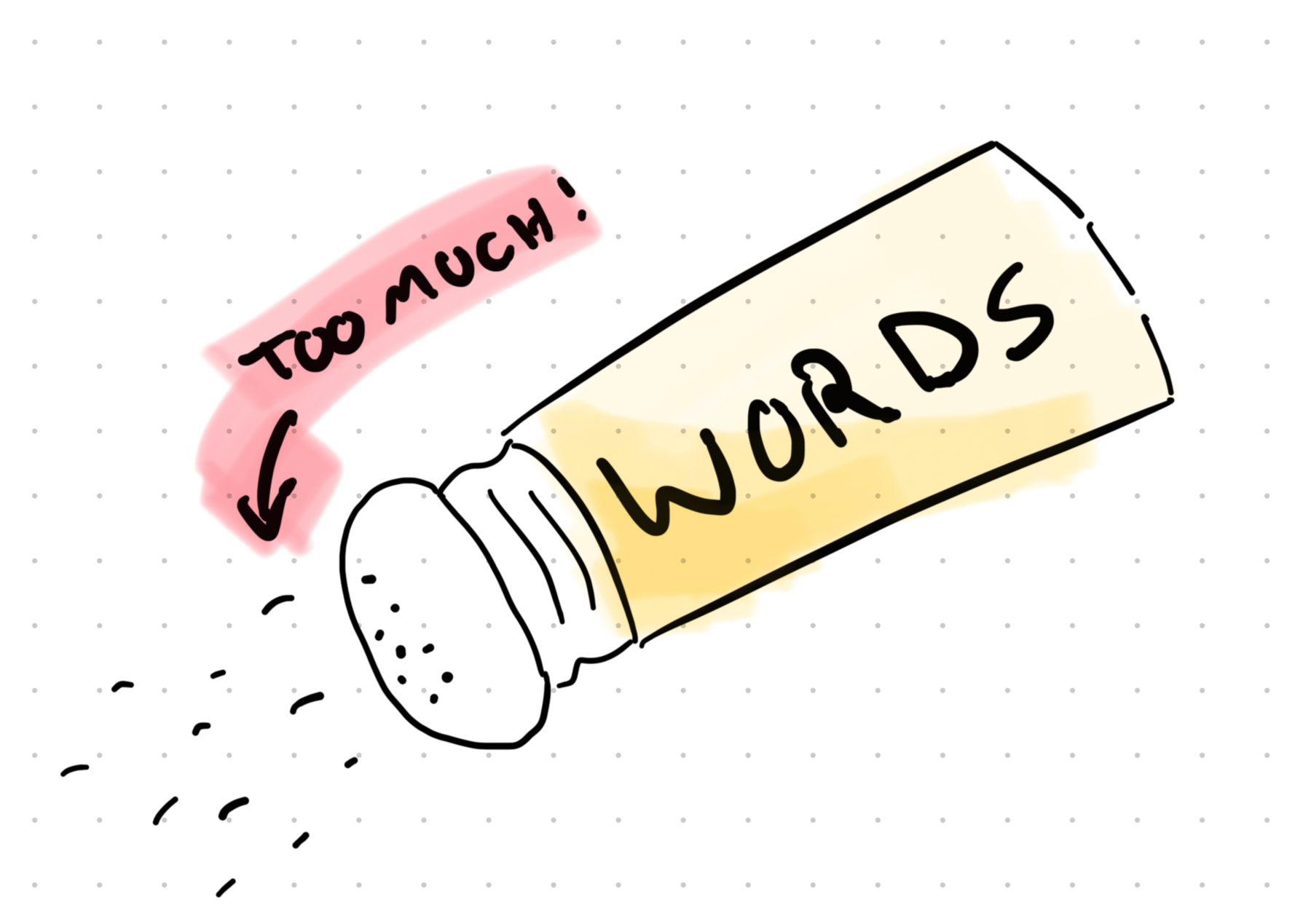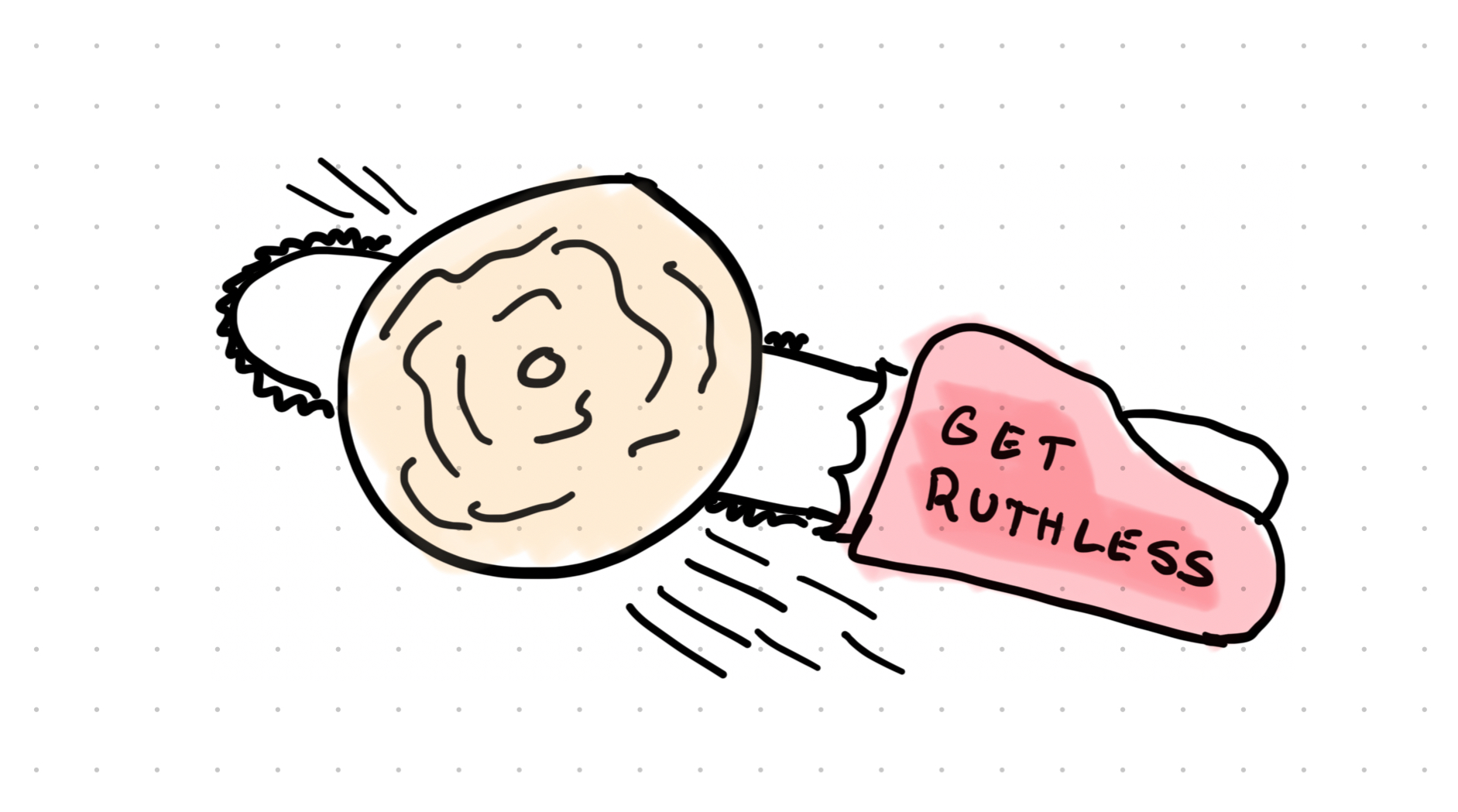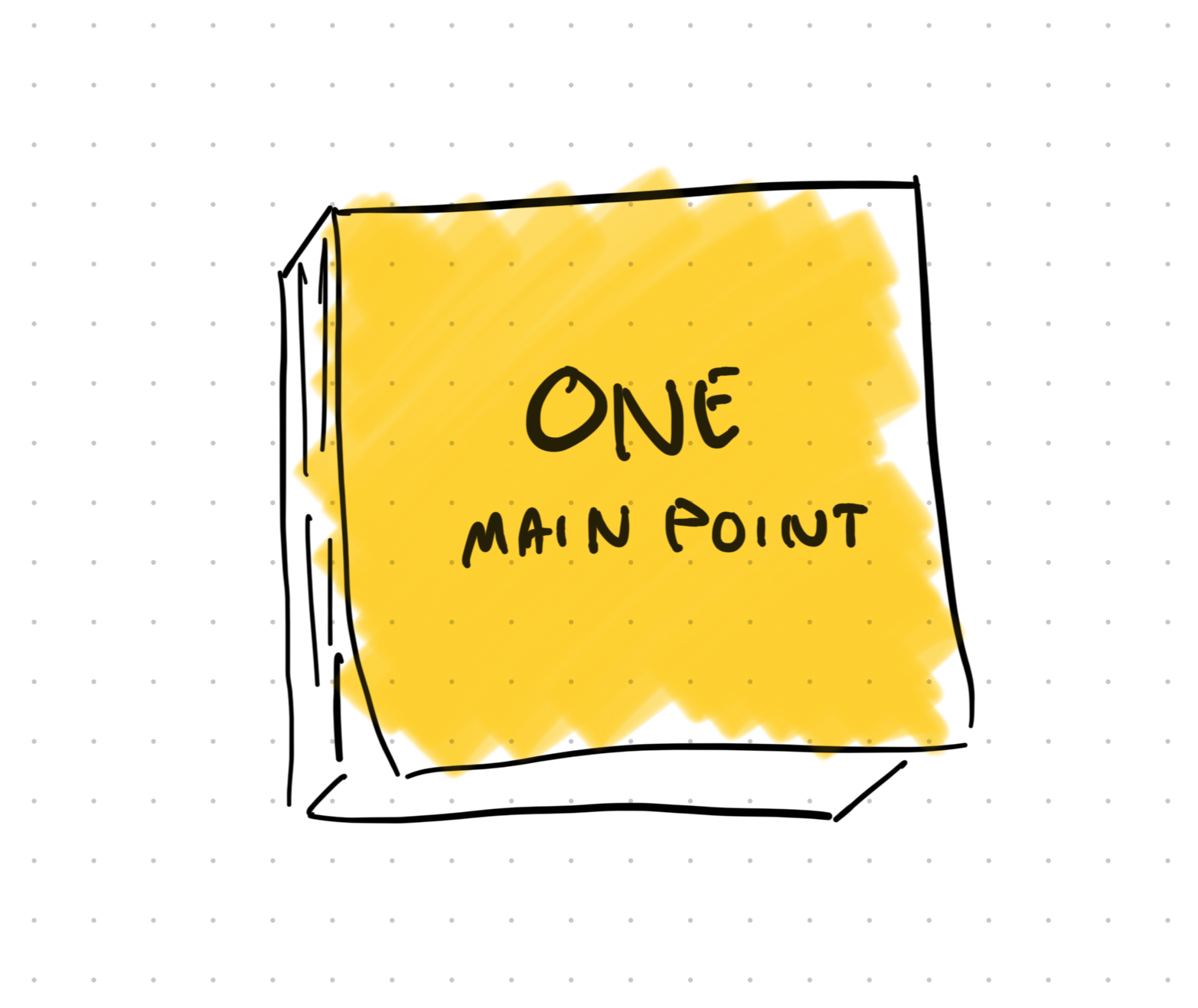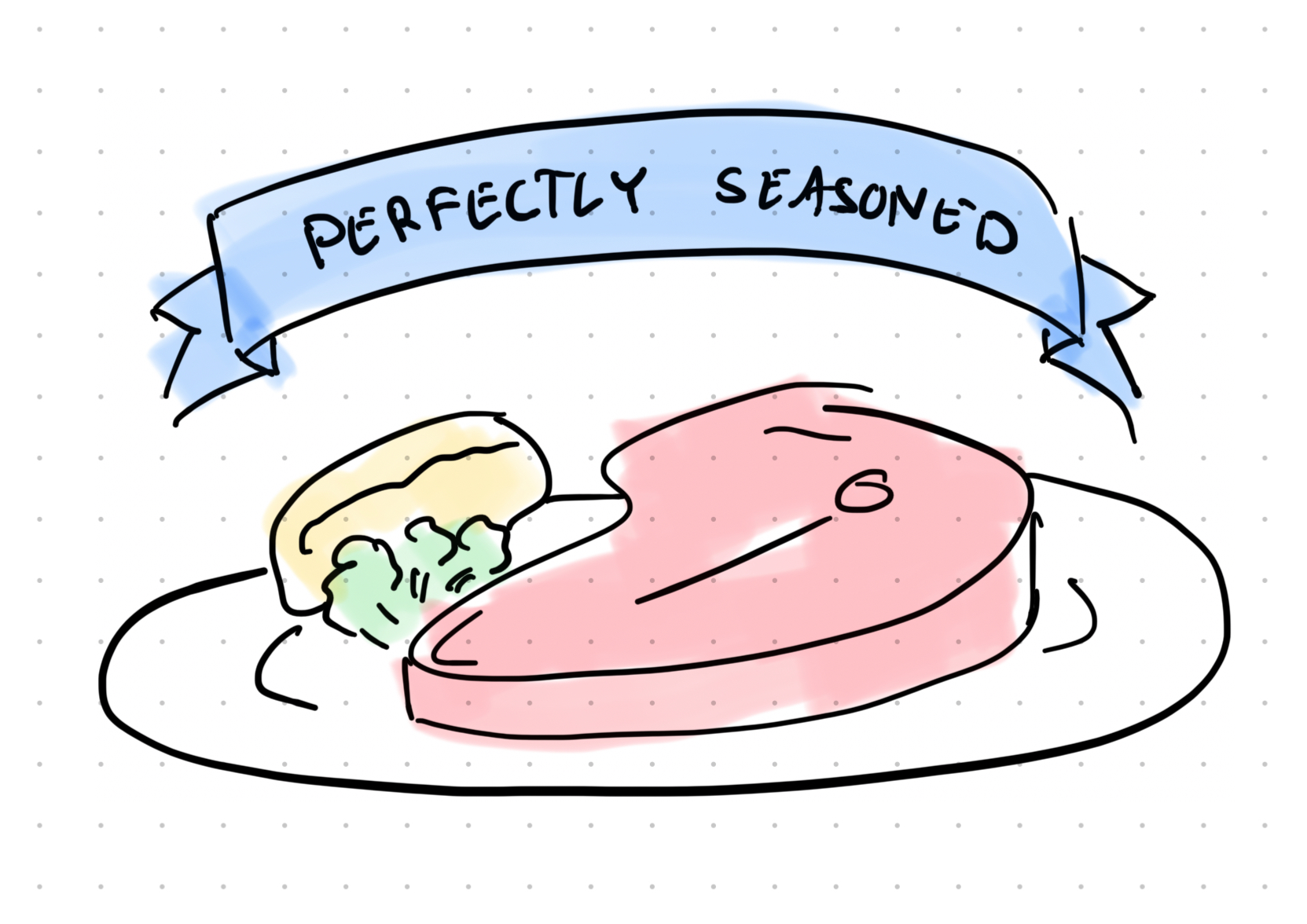Have you ever been in a meeting where you’re explaining something important to you, but you look around and notice a glaze over everyone’s eyes? People are scrolling on their computer or phone, or typing on their keyboard, or looking in your direction, but clearly not listening?
Maybe you’re explaining what’s behind a contested design decision. Or you’re delivering a profound research insight. Or explaining a huge accessibility flaw. Or maybe you’re trying to escalate a delicate, political decision that needs to be made. The information is important, but your recipient is clearly not in the same room as you (mentally anyway).
What do you do? Do you add more context? Do you clarify even more? Do you throw in another example?
Communication is a bit like cooking. You have the ingredients, but if you keep seasoning the dish, hoping it'll suddenly taste better…you’ll actually make it worse.

The Over-Seasoning Problem: Dumping the Entire Spice Rack
When a great chef prepares a beautiful dish, they have labored to prepare something that is deceptively simple.
Amateurs start with the ingredients. But, that’s not enough, so they add a pinch of salt. Then a little more. Then some pepper. Then garlic. Then paprika. Still, they aren’t satisfied with the taste so they add "just one more thing" because surely that'll make it perfect. By the time they serve it, nobody can taste the actual food. There’s more seasoning than the core ingredients in the dish.
This is what happens when most of us try to communicate. We start with some feeling, fuzzy point, or vague message. At this point it might “feel” clear, but it’s not really clear yet. So we add in context. Then we add another angle so everyone gets it. Then we drop in "just to clarify" or "another thing to consider" or "oh, and also..." We keep dumping the spice rack into the conversation until nobody knows what we're actually trying to say.
This is mental vomit. It feels productive in the moment. It feels thorough. But adding more doesn't make things clearer. It buries your point under a pile of information that nobody asked for. Plus, no one likes to be vomited on.
Can you explain the problem in one sentence? If not, you haven't reduced enough. You are over-seasoning.
Why Designers Love Salty-ness
We drone on, intentionally or not, trying to prove our point while we lose our audience along the way. We feel compelled to add a little more, just so people get it. Or we shift gears trying to recapture their attention. So why can't we stop? Well, we all have our reasons and motivations, but there’s a few common reasons we should be aware of:
- The curse of knowledge. You know so much about this problem. You've lived with it for weeks (or months). You've explored a variety of solutions. You've tested prototypes. You've read books on the issue. You’ve seen user research reports. You're convinced that if they just knew what you know, they'd get it….and that they’ll agree with you. So you try to AirDrop your entire brain into one 30 minute conversation.
- Fear of the "wrong" decision. What if you leave something out and they make a bad call? What if they choose option B because you didn't explain why option A accounts for the edge case you discovered in user testing? Or what if they choose the cheap option, not realizing the confusion it may cause? So you preemptively explain everything, just in case. But drowning them in information doesn't lead to better decisions.
- The need to prove we did the work. Designers carry a largely invisible burden. Much of the work we do isn’t made visible to our partners. We're not "just making it pretty”, we’re thinking deeply about this. We should have rationale. We should have research. We should have principles. And we’re worried if we don't explain all of it, people will think we just picked whatever looked cool. So we over-explain all the project work as a badge of credibility to earn some respect.
- Confusing completeness with clarity. We think more information equals better understanding. It doesn't. Completeness just muddies the waters of our message. Throwing everything you have at the other person isn’t the answer. In fact, a precise message, tailored to the recipient is like a hot knife through butter. But as Joseph McCormack explains in Brief, brevity requires more work on our part, not less. Reduction is hard. Addition is easy. Far too often we default to thorough instead of clear.
Over communicating makes your audience salty. The cost is high, even if we don’t immediately recognize it. It has long term impacts on how people perceive you, and the feelings they get when you interact with them.

The Cost of Too Much Salt
So what actually happens when you over-communicate? A lot. More than can realistically be addressed in an article like this. But here are four possible consequences of your loose lips:
- Lost credibility. People learn to tune you out because they know you'll keep talking whether they need you to or not. Every time you verbal-vomit, you're training them not to listen.
- Decision paralysis. You've given them seventeen factors to consider and no clear priority. Congratulations, your thoroughness just became their next problem to sort through.
- Avoidance. People start dodging your meetings…or you. They stop responding to your Slack essays. They're exhausted by the effort it takes to parse what you're actually trying to say.
- Burden shifting. You're making them do the work. They have to sift through your brain dump to figure out what matters. They have to translate your rambling into actionable next steps. That's not their job. It's yours.
If your partners can't follow you, they can't get on board with or champion your work. They can't advocate for your ideas in rooms you're not in. They can't help you because they don't know how to help.
The Art of Reduction: Finding Your Main Ingredient
So how do we fix our communication? Start with reduction—and it begins before you ever open your mouth.
Most importantly, you need to know your audience. This is the foundation. What do they need to hear, not what do you want to say? Jay Sullivan hammers this home in Simply Said: “clarity is an act of respect”. When you tailor your message to your audience's actual needs, you can cut everything that doesn't serve them. A PM needs to know the business impact. An engineer needs to know the technical constraints. A designer needs to know the user-impacts. If you're saying the same thing to everyone, you're saying too much to each of them. Focus your message on the audience need.
Here are a few points to help you:
- Build your outline beforehand. Start here. Seriously, start here. If you do one thing because of reading this article, prepare with the most basic outline for what you want to say. This was transformational for me. I started asking myself: What are the one or two things I really need this person to understand in this conversation? Grab a sticky note and write your 1-3 basic points. That outline becomes your filter. If something doesn't fit, I don't say it.
- What's the ONE thing they must understand? It’s good to have several points to make, but what’s the single thing that connects them all. Everything else should support that point. Not three different things. Not five key takeaways. One. If you can't identify it, you're not ready to communicate yet.
- Curate information, don't dump it. You're not writing a comprehensive report. You're giving them just enough to understand and act. Think of yourself as a museum curator. They don't show you every artifact in the collection. They show you the pieces that tell the story. Add the pieces that tell the story.
- Tailor ruthlessly. If it's not relevant to this specific person in this specific moment, cut it. It doesn’t matter how interesting it is. It doesn’t matter how hard you worked on it. If it doesn't serve the specific goal of this conversation, it's a distraction. Make sure every word you add is intentionally there to connect your audience to the one main point.
- Ruthlessly cut. A former mentor of mine used to say, “Cut it in half, then cut it in half again. Then you’re probably close.” This is where it gets uncomfortable. You've got to be ruthless. That fascinating research insight? Cut it. That clever connection you made? Cut it. That additional context that might be helpful? Cut it. If it doesn't directly support your main point, you are over-seasoning.
So, before your next meeting, your email, or IM, ask yourself, “Can I explain my main point in one short sentence for this audience?” If you can’t answer this audience-tailored question, spend a few more minutes getting to a better answer. You’ll never be perfect, but you can make progress toward better.

Practical Kitchen Skills: Before & After
Let’s take a look at some practical examples of what it could look like. These are all written versions, but with some discipline you can replicate this in the way you speak, too:
The Slack message that gets answers:
- Before: "Hey, wanted to touch base about the dashboard redesign. There are a few things we need to discuss around the data visualization approach, and I also had some thoughts on the navigation patterns we explored last week. When you get a chance, can we sync on this? Also wondering about your thoughts on the color palette direction..."
Problem: You're brain-dumping YOUR agenda without considering what THEY need to act on. - After: “Hey there, I need your input on dashboard nav by Friday. Main question: Should we prioritize speed (option A) or flexibility (option B)? Here’s a link to the Figma: [link]"
Why it works: Tailored to what they need to decide, nothing more.
The critique that actually helps:
- Before: "So I think there are several things we could explore here, and I'm wondering if we've considered the implications of the hierarchy, and also the balance between whitespace and density is something I've been thinking about, plus the color choices might need some refinement depending on accessibility requirements..."
Problem: Listing everything you noticed instead of focusing on what the designer needs to act on. - After: "The main issue is users won't see the primary CTA. We have a 40% drop-off at this step. One suggestion might be: Move it closer to the input areas and increase visual weight.”
Why it works: One actionable insight tailored to their immediate need.
The presentation that sticks:
- Before: 47 slides covering research methodology, competitive analysis, user personas, journey maps, wireframe iterations, visual design explorations, accessibility considerations, technical constraints…. You start the meeting, “We have a lot of exciting content to show you today, and I’m going to have to move pretty fast to cover it all.”
Problem: Showing all your work instead of serving your audience's decision. - After: 7 slide deck showing analysis of the top UX concerns, sources of data, projected financial impact, resources needed, dependencies, and partner impacts. "Today's goal: Get alignment on our Q3 UX priorities to support our corporate goal. Let's start by reviewing our 5 recommendations…”
Why it works: Designed for what your audience needs to walk away with.
The aim is that each one of these improved approaches should help your audience repeat everything you’ve said in one sentence. If they can't, keep working at it.

Season to Taste, Not to Excess
Good communication takes work. Being unprepared and unfocused is the path of least resistance, but it’s a trap. Commit to the hard work of reduction. Be disciplined. Practice. Trust that saying less is usually better. Because the payoff is real. People will want to work with you because you make their lives easier, not harder.
So next time you're about to communicate, whether it's a Slack message, a critique, or a presentation…start by asking: What does this person need from me right now? What do they need to hear? Not what do I want to say. Then say that and see what happens.
Your partners will thank you. Your calendar will thank you. And, you'll thank yourself when you see people sit forward and listen like they’ve never listened before.
They’ll taste the beauty of the food, instead of leaving them salty. Good luck!